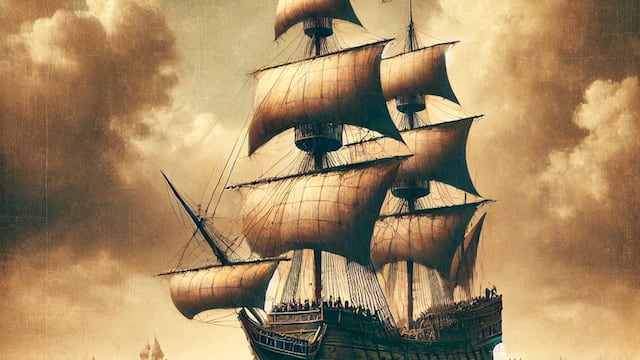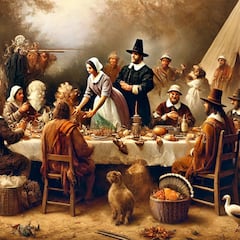Feast, family, football, friendship... but what was the story behind the sailing flower where it all originated?

This was the Mayflower, the ship that took two months to cross the Atlantic from Plymouth and gave birth to Thanksgiving

In September 1620, the Mayflower set sail from Plymouth, England, carrying 102 passengers on a mission they likely romanticized before reality hit. These passengers, now celebrated as the Pilgrims, weren’t the first to cross the Atlantic – but their voyage turned out to be one of the most storied in American history. And for good reason: it was a slog. Sixty-six days of cramped, leaky misery aboard a ship designed for hauling wine and dry goods, not people.
The passengers crammed into the Mayflower’s gun deck, a space with a very low ceiling, shared their journey with livestock and the occasional bucket of seawater. Strong westerly gales pummeled the ship, which didn’t help the already bleak sanitary conditions. Leaks sprang, tempers flared, and seasickness, while common, was probably the least of anyone’s worries.
Angela Davis' ancestors arrived in America on the Mayflower. pic.twitter.com/dnwrG6fB6U
— Christopher F. Rufo ⚔️ (@christopherrufo) February 22, 2023
Where did the Mayflower land?
The Pilgrims were fleeing religious persecution, but noble aspirations didn’t make the Atlantic any less brutal. After over two months of rough seas, on November 9, 1620, they finally spotted land: Cape Cod. It was a huge relief – except it wasn’t where they’d intended to end up. They’d been aiming for the Hudson River, but heavy weather had other ideas.
#OTD in 1620, passengers aboard the Mayflower signed the Mayflower Compact, agreeing to abide by the laws of the government that they would establish. Read about the 17th-century Puritans aboard the Mayflower who settled the Massachusetts Bay Colony.https://t.co/rlqBfdKOhx pic.twitter.com/7VovYLsB2Q
— Archaeology Magazine (@archaeologymag) November 21, 2024
By November 11, they anchored in Provincetown Harbor, where the men aboard drafted and signed the Mayflower Compact. This document, a somewhat hasty but historic agreement, laid out basic principles of self-governance. It’s often cited as a cornerstone of American democracy, which is impressive for something written by men who’d just survived two months in a floating wooden box.
The grim first winter and the origins of Thanksgiving
The relief of making landfall was short-lived. The Pilgrims spent the brutal winter of 1620-1621 battling disease, exposure, and malnutrition. By spring, nearly half of them – and much of the ship’s crew – had died. It’s a grim reminder that even when you’ve finally reached your destination, the struggle isn’t necessarily over.
But the survivors were resilient. They established Plymouth Colony, with help from Indigenous people like the Wampanoag, whose contributions were essential to their survival. By the fall of 1621, the colonists had enough of a harvest to hold a celebratory feast. That event, a mix of gratitude and relief, later became enshrined as the first Thanksgiving, though it bore little resemblance to today’s turkey-filled holiday.
#OTD in #history 1620, the #Mayflower Compact was signed. Winds pushed the #Pilgrims from their intended destination, threatening mutiny once ashore. The Compact was thus "the first foundation of their government in this place,” the governor explained, to ensure order—& survival. pic.twitter.com/jVs4ZXfApP
— US Capitol Historical Society (@CapitolHistory) November 21, 2024
The Mayflower: a ship, a symbol
The Mayflower was no luxury liner, and its passengers weren’t pampered adventurers. Yet the story of their voyage has become a symbol of determination and the pursuit of freedom. While half of them didn’t make it to the second Thanksgiving, their legacy continues in the annual November tradition.
So when you’re piling your plate with stuffing and pie, it’s worth sparing a thought for the Pilgrims – and maybe raising a glass to the battered little ship that carried them across the Atlantic. Let’s just be glad we have airplanes now.
Related stories

The first ever Thanksgiving meal

Jason Kelce shares how to fix the perfect Thanksgiving turkey
Get your game on! Whether you’re into NFL touchdowns, NBA buzzer-beaters, world-class soccer goals, or MLB home runs, our app has it all.
Dive into live coverage, expert insights, breaking news, exclusive videos, and more – plus, stay updated on the latest in current affairs and entertainment. Download now for all-access coverage, right at your fingertips – anytime, anywhere.
Complete your personal details to comment